Reproduce PySM 2 synchrotron polarization templates¶
The purpose of this notebook is to reproduce the analysis described in the PySM 2 paper to prepare the input templates used in the Galactic dust and synchrotron models. In summary we take input template maps from Planck or other sources, smooth them to remove noise and add small scale gaussian fluctuations.
[1]:
import os
import healpy as hp
import matplotlib.pyplot as plt
import numpy as np
from astropy.io import fits
%matplotlib inline
[2]:
import os
os.environ["OMP_NUM_THREADS"] = "32"
[3]:
hp.disable_warnings()
[4]:
plt.style.use("seaborn-talk")
[5]:
import pysm3 as pysm
import pysm3.units as u
[6]:
nside = 512
lmax = 3 * nside - 1
Masks¶
For synchrotron we use the WMAP polarization analysis mask
[7]:
wmap_mask_filename = "wmap_polarization_analysis_mask_r9_9yr_v5.fits"
[8]:
if not os.path.exists(wmap_mask_filename):
!wget https://lambda.gsfc.nasa.gov/data/map/dr5/ancillary/masks/$wmap_mask_filename
[9]:
fits.open(wmap_mask_filename)[1].header
[9]:
XTENSION= 'BINTABLE' /binary table extension
BITPIX = 8 /8-bit bytes
NAXIS = 2 /2-dimensional binary table
NAXIS1 = 8 /width of table in bytes
NAXIS2 = 3145728 /number of rows in table
PCOUNT = 0 /size of special data area
GCOUNT = 1 /one data group (required keyword)
TFIELDS = 2 /number of fields in each row
TTYPE1 = 'TEMPERATURE' /label for field 1
TFORM1 = 'E ' /data format of field: 4-byte REAL
TUNIT1 = 'mK ' /physical unit of field 1
TTYPE2 = 'N_OBS ' /label for field 2
TFORM2 = 'E ' /data format of field: 4-byte REAL
TUNIT2 = 'counts ' /physical unit of field 2
EXTNAME = 'Archive Map Table' /name of this binary table extension
PIXTYPE = 'HEALPIX ' /Pixel algorigthm
ORDERING= 'NESTED ' /Ordering scheme
NSIDE = 512 /Resolution parameter
FIRSTPIX= 0 /First pixel (0 based)
LASTPIX = 3145727 /Last pixel (0 based)
[10]:
wmap_mask = hp.read_map(wmap_mask_filename,0)
[11]:
hp.mollview(wmap_mask, title="WMAP DR5 polarization analysis mask")
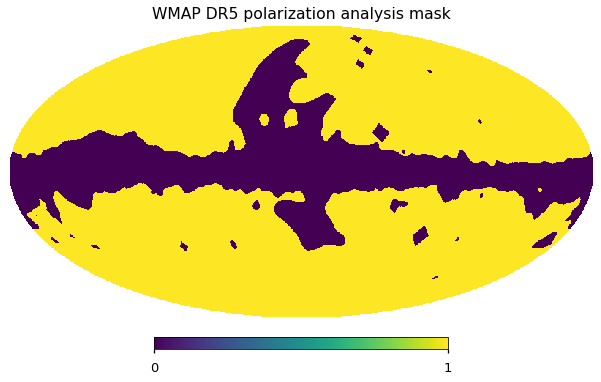
[12]:
total_mask = hp.ud_grade(wmap_mask, nside)
[13]:
f_sky = total_mask.sum()/len(total_mask)
[14]:
f_sky
[14]:
0.7315705617268881
[15]:
hp.mollview(total_mask, title="Total mask")
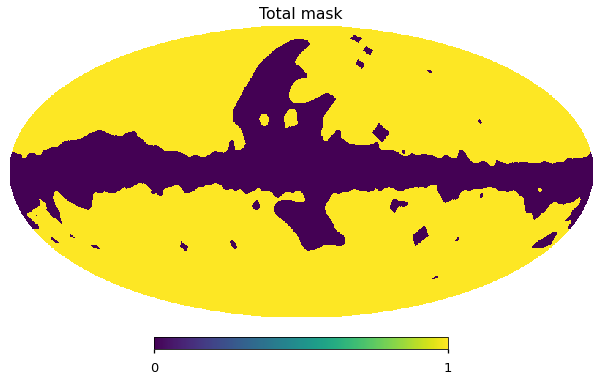
[ ]:
Synchrotron model¶
Spectral index¶
As in the nominal Planck Sky Model v1.7.8 simulations, we use the spectral index map from ‘Model 4’ of MivilleDeschenes et al. (2008), calculated from a combination of Haslam and WMAP 23 GHz polarization data using a model of the Galactic magnetic field.
[16]:
pysm2_beta = hp.read_map("https://portal.nersc.gov/project/cmb/pysm-data/pysm_2/synch_beta.fits")
[17]:
hp.mollview(pysm2_beta, title="Synchrotron spectral index from MivilleDeschenes 2008")
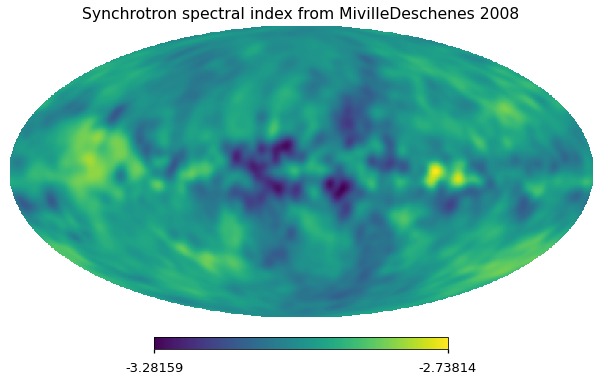
[18]:
hp.npix2nside(len(pysm2_beta))
[18]:
512
Synchrotron templates¶
The nominal PySM model assumes that the synchrotron intensity is a scaling of the degree-scale-smoothed 408 MHz Haslam map (Haslam et al. 1981; Haslam et al. 1982), reprocessed by Remazeilles et al. (2014). It models the polarization as a scaling of the WMAP 9-year 23 GHz Q and U maps (Bennett et al. 2013), smoothed to three degrees.
[19]:
wmap_23GHz_map_filename = "wmap_band_iqumap_r9_9yr_K_v5.fits"
[20]:
if not os.path.exists(wmap_23GHz_map_filename):
!wget https://lambda.gsfc.nasa.gov/data/map/dr5/skymaps/9yr/raw/$wmap_23GHz_map_filename
[21]:
wmap_23GHz_map,wmap_23GHz_header = hp.read_map(wmap_23GHz_map_filename, (0,1,2), h=True)
[22]:
wmap_23GHz_header
[22]:
[('XTENSION', 'BINTABLE'),
('BITPIX', 8),
('NAXIS', 2),
('NAXIS1', 16),
('NAXIS2', 3145728),
('PCOUNT', 0),
('GCOUNT', 1),
('TFIELDS', 4),
('TTYPE1', 'TEMPERATURE'),
('TFORM1', 'E'),
('TUNIT1', 'mK,thermodynamic'),
('TTYPE2', 'Q_POLARISATION'),
('TFORM2', 'E'),
('TUNIT2', 'mK,thermodynamic'),
('TTYPE3', 'U_POLARISATION'),
('TFORM3', 'E'),
('TUNIT3', 'mK,thermodynamic'),
('TTYPE4', 'N_OBS'),
('TFORM4', 'E'),
('TUNIT4', 'counts'),
('EXTNAME', 'Stokes Maps'),
('DATE', 0),
('PIXTYPE', 'HEALPIX'),
('ORDERING', 'NESTED'),
('NSIDE', 512),
('FIRSTPIX', 0),
('LASTPIX', 3145727)]
[23]:
wmap_23GHz_map <<= u.mK_CMB
[24]:
wmap_23GHz_map
[24]:
[25]:
for i_pol, pol in [(1, "Q"), (2, "U")]:
hp.mollview(wmap_23GHz_map[i_pol].to_value("uK_CMB"), title="WMAP polarization " + pol, unit="uK_CMB", min=-300, max=300)
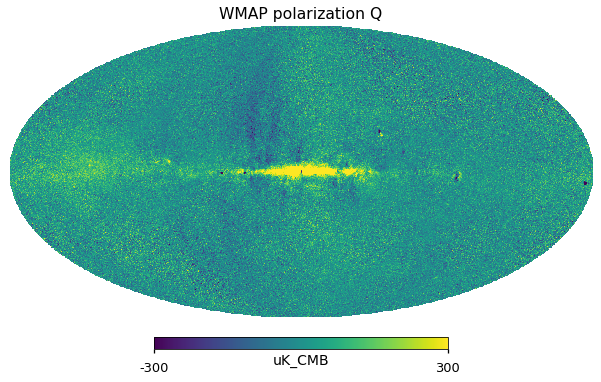
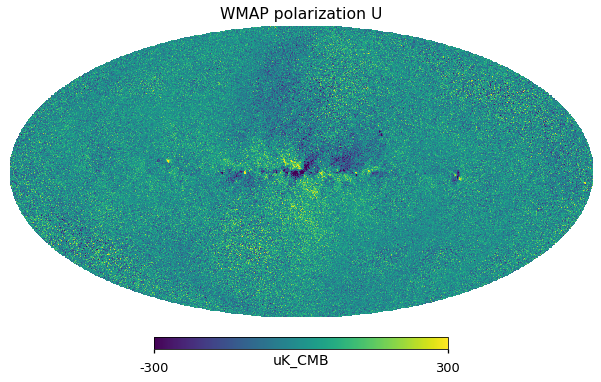
[26]:
target_unit = u.uK_RJ
[27]:
K_CMB_2_K_RJ = (1 * wmap_23GHz_map.unit).to_value(target_unit , equivalencies=u.cmb_equivalencies(23*u.GHz))
[28]:
K_CMB_2_K_RJ
[28]:
986.4426641608574
This is the effective frequency of the WMAP K band using the effective frequency calculator from https://lambda.gsfc.nasa.gov/product/map/current/effective_freq.cfm using a spectral index of -3:
[29]:
(1 * u.K_CMB).to(u.K_RJ , equivalencies=u.cmb_equivalencies(2.24357e+01*u.GHz))
[29]:
[30]:
smoothing_fwhm = 3 * u.deg
[31]:
ell_star_synch = 36
[32]:
#synch_amplitude = hp.smoothing(wmap_23GHz_map.value, fwhm=(180 * u.deg / ell_star_synch).to_value(u.rad)) * wmap_23GHz_map.unit
[33]:
synch_amplitude = wmap_23GHz_map
[34]:
wmap_23GHz_frequency = 2.24357e+01*u.GHz
[35]:
synch_amplitude = synch_amplitude.to(target_unit, equivalencies=u.cmb_equivalencies(wmap_23GHz_frequency))[1:]
Angular power spectrum¶
We use namaster to estimate the power spectrum of the masked map, compared to anafast, namaster properly deconvolves the mask to remove the correlations between different \(C_\ell\) caused by the mask.
We don’t need to deconvolve the beam, we won’t be using the values at high \(\ell\) anyway.
[36]:
from reprocess_utils import run_namaster
[37]:
ell, cl = run_namaster(synch_amplitude, total_mask)
[38]:
import pymaster as nmt
mask = total_mask
m = synch_amplitude
[39]:
binning = nmt.NmtBin.from_nside_linear(hp.npix2nside(m.shape[-1]), 1)
ell_arr = binning.get_effective_ells()
ell_arr = np.concatenate([[0, 0], ell_arr])
f_2 = nmt.NmtField(
mask, m.copy()
) # namaster overwrites the map in place with the mask
cl_22 = nmt.compute_full_master(f_2, f_2, binning)
cl = np.zeros((3, len(ell_arr)), dtype=np.double)
cl[1, 2:] = cl_22[0]
cl[2, 2:] = cl_22[3]
[40]:
plt.loglog(cl_22[2])
[40]:
[<matplotlib.lines.Line2D at 0x2aaade1fbf90>]
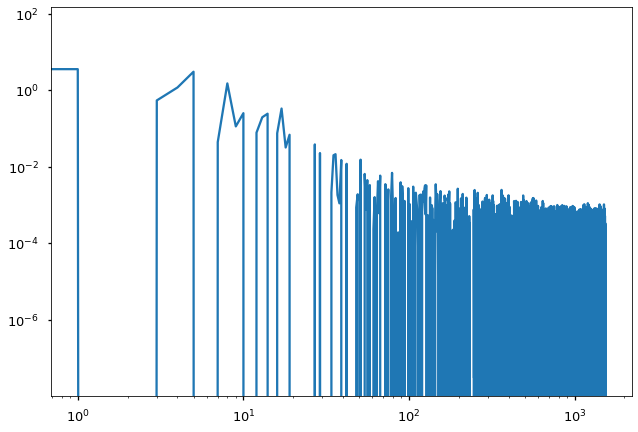
[41]:
cl.shape
[41]:
(3, 1536)
[42]:
cl_norm = ell*(ell+1)/np.pi/2
We plot the output power spectrum and also identify a range in \(\ell\) before white noise starts dominating and after the uncertainty at low-\(\ell\).
The power spectrum features a power law behaviour \(\ell < 200\) (linear in loglog axes), then white noise starts picking up until \(\ell=1000\) and then we see the smoothing applied to the maps (10 arcminutes).
[43]:
ell_fit_low = 2
ell_fit_high = 80
Fit noise bias¶
[44]:
noise_bias_ell_low = 700
noise_bias_ell_high = 1000
noise_bias = (cl[1:, noise_bias_ell_low:noise_bias_ell_high]).mean(axis=1)
noise_bias = {"EE":noise_bias[0], "BB":noise_bias[1]}
[45]:
# noise_bias["BB"] = noise_bias["EE"]
[46]:
noise_bias
[46]:
{'EE': 0.015947944576014617, 'BB': 0.016036643055908954}
[47]:
plt.plot(cl[1], label="EE $C_\ell$")
plt.loglog(cl[2], label="BB $C_\ell$")
plt.axvline(ell_fit_low, linestyle="--", color="black", label="$ \ell={} $".format(ell_fit_low))
plt.axvline(ell_fit_high, linestyle="--", color="gray", label="$ \ell={} $".format(ell_fit_high))
for pol,color in zip(["EE", "BB"], ["violet", "red"]):
plt.axhline(noise_bias[pol], color=color, label=f"noise bias {pol}")
plt.axvline(noise_bias_ell_low, ls="--", label=f"noise bias averaging range")
plt.axvline(noise_bias_ell_high, ls="--", label=f"noise bias averaging range")
plt.legend()
#plt.xlim(2,200)
plt.ylim(0,.1)
plt.grid();
/global/u2/z/zonca/condanamaster/lib/python3.7/site-packages/ipykernel_launcher.py:12: UserWarning: Attempted to set non-positive bottom ylim on a log-scaled axis.
Invalid limit will be ignored.
if sys.path[0] == '':
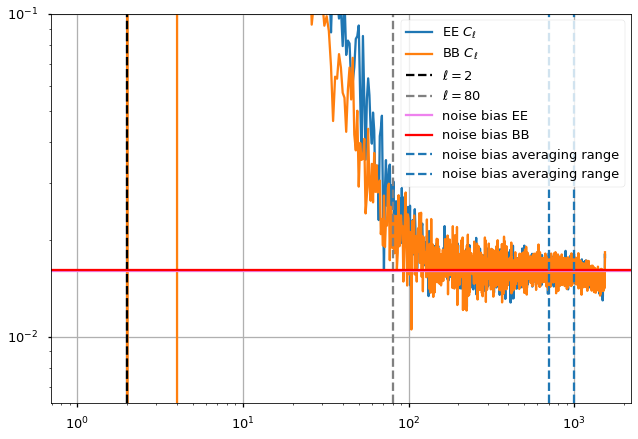
[48]:
(cl_norm * cl[2])[2]
[48]:
30.3156583368453
[49]:
cosmic_variance = np.sqrt(2/((2*ell+1)*f_sky))*cl
[50]:
cosmic_variance
[50]:
array([[0.00000000e+00, 0.00000000e+00, 0.00000000e+00, ...,
0.00000000e+00, 0.00000000e+00, 0.00000000e+00],
[0.00000000e+00, 0.00000000e+00, 2.64565298e+02, ...,
5.18685174e-04, 5.39284500e-04, 5.26832396e-04],
[0.00000000e+00, 0.00000000e+00, 2.34745625e+01, ...,
4.88834528e-04, 5.44243575e-04, 5.45132045e-04]])
[51]:
plt.figure(figsize=(15,8))
plt.errorbar(ell, cl_norm* cl[1], yerr=cosmic_variance[1]*cl_norm, color="green", label="EE $C_\ell$", mew=1, capsize=3)
plt.errorbar(ell, cl_norm * cl[2], yerr=cosmic_variance[2]*cl_norm, color="blue", label="BB $C_\ell$", mew=1, capsize=3)
plt.axvline(ell_fit_low, linestyle="--", color="black", label="$ \ell={} $".format(ell_fit_low))
plt.axvline(ell_fit_high, linestyle="--", color="gray", label="$ \ell={} $".format(ell_fit_high))
for pol,color in zip(["EE", "BB"], ["violet", "red"]):
plt.axhline(noise_bias[pol], color=color, label=f"noise bias {pol}")
plt.legend()
ax = plt.gca()
ax.set_yscale('log')
ax.set_xscale('log')
plt.xlabel("$\ell$")
plt.ylabel("$\ell(\ell+1)/2\pi~C_\ell~[\mu K_{RJ}^2]$")
plt.xlim(2,200)
plt.ylim(8,2e2)
plt.grid();
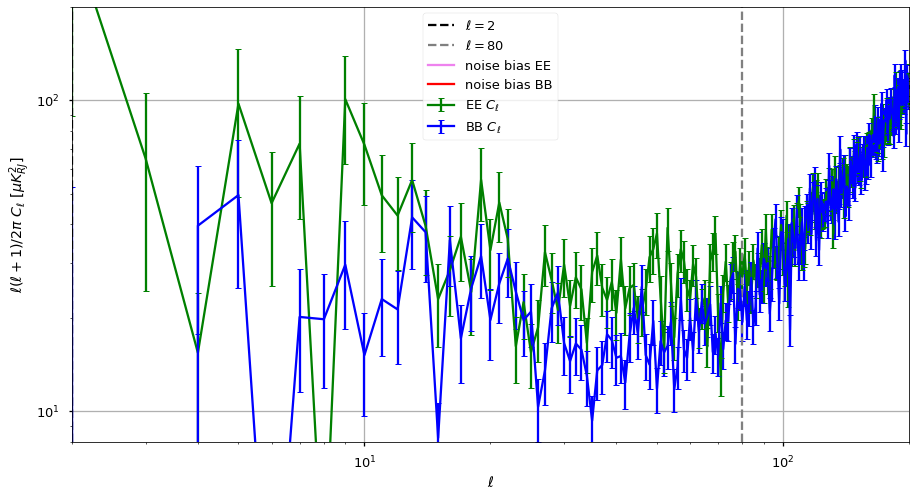
[52]:
plt.loglog(cl[1]-noise_bias["EE"], label="EE $C_\ell$")
plt.plot(cl[2]-noise_bias["BB"], label="BB $C_\ell$")
plt.axvline(ell_fit_low, linestyle="--", color="black", label="$ \ell={} $".format(ell_fit_low))
plt.axvline(ell_fit_high, linestyle="--", color="gray", label="$ \ell={} $".format(ell_fit_high))
for pol,color in zip(["EE", "BB"], ["violet", "red"]):
plt.axhline(noise_bias[pol], color=color, label=f"noise bias {pol}")
plt.legend()
#plt.xlim(2,200)
plt.grid();
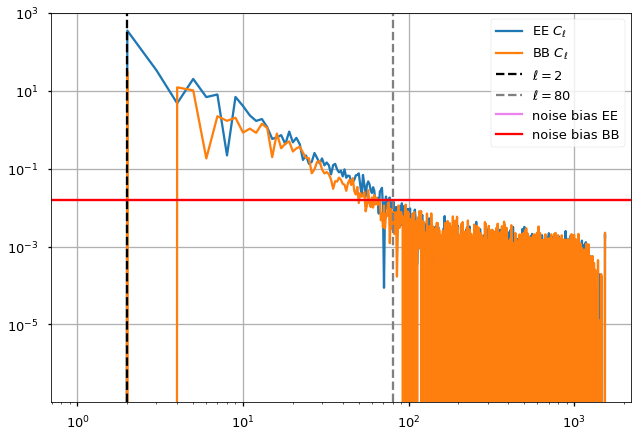
Fit slope at high ell¶
[53]:
from scipy.optimize import curve_fit
[54]:
def model(ell, A, gamma):
return A * ell ** gamma# + N* ell*(ell+1)/np.pi/2
[55]:
xdata = np.arange(ell_fit_low, ell_fit_high)
[56]:
cl_norm
[56]:
array([0.00000000e+00, 0.00000000e+00, 9.54929659e-01, ...,
3.74272266e+05, 3.74760553e+05, 3.75249159e+05])
[57]:
A_fit, gamma_fit, A_fit_std, gamma_fit_std = {},{},{},{}
N_fit = {}
for pol,i_pol in [("EE",1),("BB",2)]:
ydata = xdata*(xdata+1)/np.pi/2 * (cl[i_pol][xdata] - noise_bias[pol])
(A_fit[pol], gamma_fit[pol]), cov = curve_fit(model, xdata, ydata, sigma=(cosmic_variance[i_pol])[ell_fit_low:ell_fit_high])
#A_fit_std[pol], gamma_fit_std[pol] = np.sqrt(np.diag(cov))
plt.figure()
plt.loglog(ell*(ell+1)/np.pi/2 * (cl[i_pol]), label="spice $C_\ell$")
plt.loglog(A_fit[pol]*ell**gamma_fit[pol], label="model fit")
plt.axvline(ell_fit_low, linestyle="--", color="black", label="$ \ell={} $".format(ell_fit_low))
plt.axvline(ell_fit_high, linestyle="--", color="gray", label="$ \ell={} $".format(ell_fit_high))
plt.legend()
plt.grid()
plt.title(f"{pol} power spectrum for synchrotron")
plt.xlim(2,200)
plt.ylim(1,200)
#plt.ylim(1, 30);
/global/u2/z/zonca/condanamaster/lib/python3.7/site-packages/ipykernel_launcher.py:11: RuntimeWarning: divide by zero encountered in power
# This is added back by InteractiveShellApp.init_path()
/global/u2/z/zonca/condanamaster/lib/python3.7/site-packages/ipykernel_launcher.py:11: RuntimeWarning: divide by zero encountered in power
# This is added back by InteractiveShellApp.init_path()
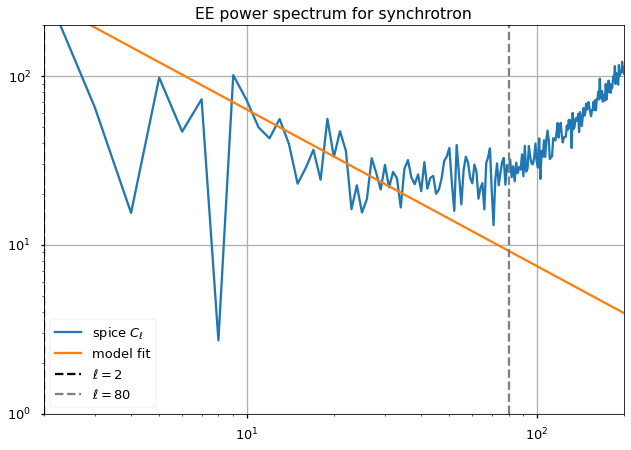
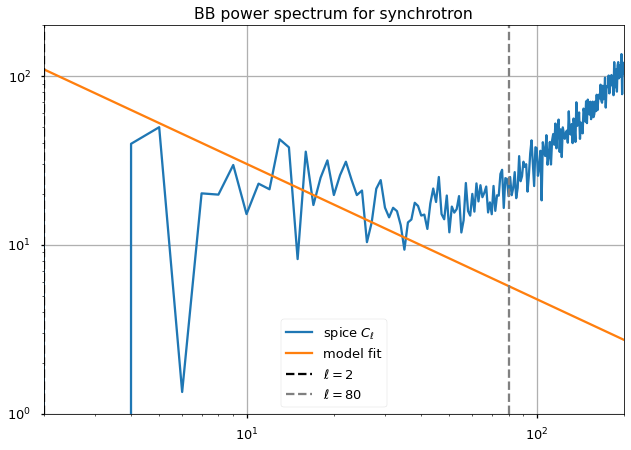
[58]:
from IPython.display import Image
Image("BB_synch_inputs_PySM_2_paper.png")
[58]:
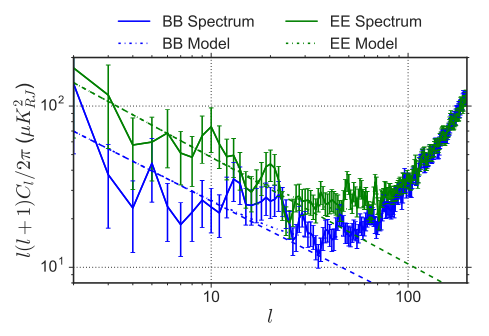
The paper mentions a \(\gamma^{EE,synch} = -.66\) and a \(\gamma^{BB,synch} = -.62\).
[59]:
gamma_fit
[59]:
{'EE': -0.9271577933916797, 'BB': -0.8010580744726311}
Window function¶
The window function is used to smooth the input templates to remove the high \(\ell\) noise and its inverse is used for the added small scales.
In the paper it mentions that the large scales map is smoothed with a beam of \(180/\ell_*^{synch}\) degrees, but looking at the PySM 2 templates, it looks like the spectrum is still flat after the supposed cutoff of the beam, see the end of this notebook.
So I tested using the same \(\ell_*\) used for dust, i.e. 2.6 deg smoothingi instead of 5, but still the spectrum in PySM 2 seems flatter at intermediate \(\ell\).
\(\ell_*^{synch}\)
[60]:
ell_star = 36
ell_star = 69
[61]:
theta_fwhm_deg = 180/ell_star
[62]:
theta_fwhm_deg
[62]:
2.608695652173913
[63]:
theta_fwhm = np.radians(theta_fwhm_deg)
[64]:
w_ell = hp.gauss_beam(fwhm=theta_fwhm, lmax=lmax)
[65]:
w_ell.shape
[65]:
(1536,)
Process patches¶
This process doesn’t have a large impact on the output spectra, the idea is that in each \(N_{side}=2\) pixel we want to scale the gaussian fluctuations so that they are consistent with the power at low ell. So we will have higher gaussian fluctuations on the galaxy where there is stronger dust emission.
[66]:
patch_indices = hp.ud_grade(np.arange(hp.nside2npix(2)), nside)
[67]:
zeros = np.zeros(len(ell), dtype=np.double)
[68]:
inv_w_ell = 1 - w_ell**2
[69]:
nside_patches = 2
n_patches = hp.nside2npix(nside_patches)
[70]:
m_sigma_G = hp.synfast([
zeros,
A_fit["EE"] * ell**gamma_fit["EE"] * inv_w_ell / cl_norm,A_fit["BB"] * ell**gamma_fit["BB"] * inv_w_ell / cl_norm,
zeros, zeros, zeros], nside, new=True)
/global/u2/z/zonca/condanamaster/lib/python3.7/site-packages/ipykernel_launcher.py:3: RuntimeWarning: divide by zero encountered in power
This is separate from the ipykernel package so we can avoid doing imports until
/global/u2/z/zonca/condanamaster/lib/python3.7/site-packages/ipykernel_launcher.py:3: RuntimeWarning: invalid value encountered in multiply
This is separate from the ipykernel package so we can avoid doing imports until
[71]:
N = {i_pol:np.zeros(n_patches, dtype=np.double) for i_pol in [1,2]}
[72]:
synch_amplitude = wmap_23GHz_map.to(u.uK_RJ, equivalencies=u.cmb_equivalencies(wmap_23GHz_frequency))
[73]:
synch_amplitude[0]=0
[74]:
m_planck_smoothed = hp.alm2map(hp.smoothalm(hp.map2alm(synch_amplitude.value, use_pixel_weights=True), fwhm=theta_fwhm),
nside=nside)
[75]:
for i_patch in range(n_patches):
print(i_patch)
m_patch = np.zeros_like(m_planck_smoothed)
m_patch[1:, patch_indices == i_patch] = m_planck_smoothed[1:, patch_indices == i_patch]
cl_patch = hp.anafast(m_patch, lmax=2*ell_star, use_pixel_weights=True)
for pol,i_pol in [("EE", 1),("BB",2)]:
N[i_pol][i_patch] = np.sqrt(cl_patch[i_pol][ell_star] / n_patches / (A_fit[pol] * ell_star ** gamma_fit[pol]))
0
1
2
3
4
5
6
7
8
9
10
11
12
13
14
15
16
17
18
19
20
21
22
23
24
25
26
27
28
29
30
31
32
33
34
35
36
37
38
39
40
41
42
43
44
45
46
47
[76]:
plt.loglog(cl_patch[1])
plt.axvline(ell_star)
[76]:
<matplotlib.lines.Line2D at 0x2aaae63c7b10>
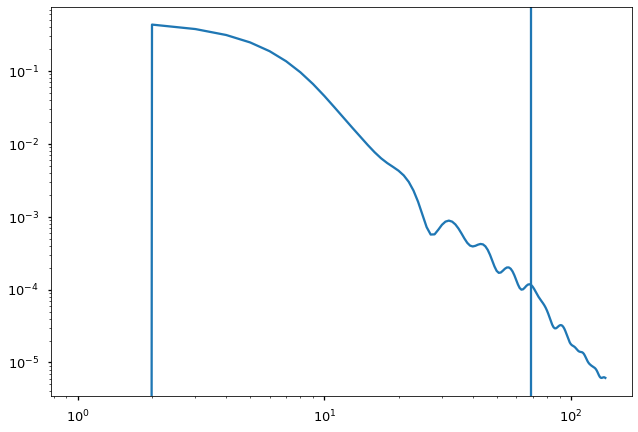
[77]:
hp.mollview(N[1])
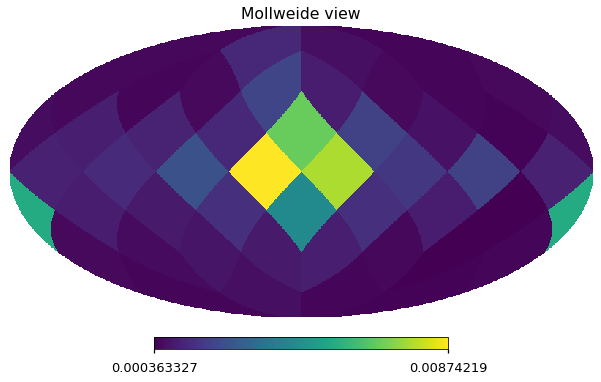
[78]:
m_zeros = np.zeros(hp.nside2npix(nside), dtype=np.double)
[79]:
N_smoothed = hp.smoothing([m_zeros, hp.ud_grade(N[1], nside), hp.ud_grade(N[2], nside)], fwhm=np.radians(10))
[80]:
N_smoothed[1] /= N_smoothed[1].mean()
[81]:
N_smoothed[2] /= N_smoothed[2].mean()
[82]:
hp.mollview(N_smoothed[1], cmap="jet")
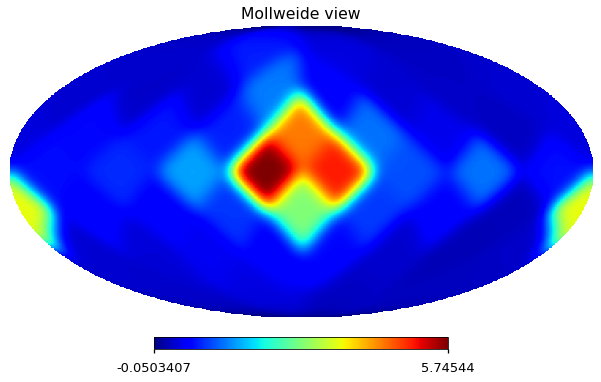
This also is quite different from Figure 9 in the paper, but it is not the main issue, possibly I need to use PolSpice instead of anafast?
[83]:
hp.mollview(N_smoothed[1], min=0, max=6, cmap="jet")
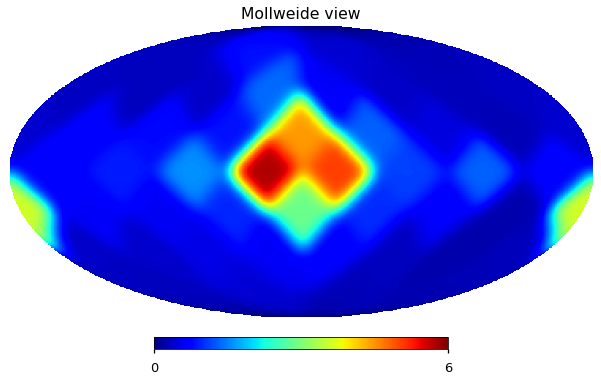
Run PolSpice on the total map and just on the small scales¶
Always using the same Gal80 Planck mask
[84]:
m_total = m_planck_smoothed + m_sigma_G * N_smoothed
[85]:
m_total[0] = 1
[86]:
_, cl_total = run_namaster(m_total[1:], total_mask)
[87]:
m_sigma_G[0]=0
[88]:
_, cl_sigma_G_uniform = run_namaster(m_sigma_G[1:], total_mask)
Download PySM 2 templates¶
[89]:
for comp in "qu":
filename = f"synch_{comp}_new.fits"
if not os.path.exists(filename):
!wget https://portal.nersc.gov/project/cmb/pysm-data/pysm_2/$filename
[90]:
m_pysm2 = np.array([hp.read_map(f"synch_{comp}_new.fits") for comp in "qu"])
[91]:
total_mask_512 = hp.ud_grade(total_mask, 512)>=.75
[92]:
ell_arr_512, cl_pysm2 = run_namaster(m_pysm2, total_mask_512)
Compare PySM 2, the input and the output¶
[93]:
for pol, i_pol in [("EE",1),("BB",2)]:
plt.figure(figsize=(10,6))
plt.loglog(cl_norm[:cl_pysm2.shape[1]]*cl_pysm2[i_pol], label="pysm2")
#plt.loglog(cl_norm*cl_sigma_G_normalized[i_pol], label="SS")
plt.loglog(cl_norm*cl_total[i_pol], label="This notebook")
plt.loglog(cl_norm*cl[i_pol], label="Input template")
plt.loglog(10*w_ell**2, label="Beam window")
plt.loglog(A_fit[pol] * ell**gamma_fit[pol], label="High ell spectrum fit")
plt.axvline(ell_star, color="black")
plt.title(pol)
plt.legend()
plt.xlim([1,1000])
plt.ylim([1e0, 1e2])
plt.xlabel("$\ell$")
plt.ylabel("$\ell(\ell+1)/2\pi~C_\ell~[\mu K_{RJ}^2]$")
plt.grid();
/global/u2/z/zonca/condanamaster/lib/python3.7/site-packages/ipykernel_launcher.py:9: RuntimeWarning: divide by zero encountered in power
if __name__ == '__main__':
/global/u2/z/zonca/condanamaster/lib/python3.7/site-packages/ipykernel_launcher.py:9: RuntimeWarning: divide by zero encountered in power
if __name__ == '__main__':
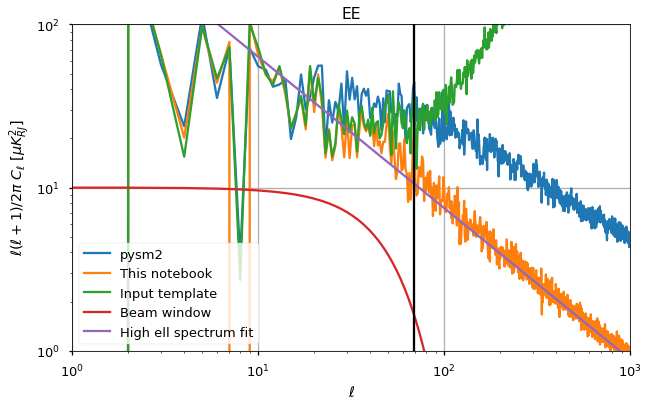
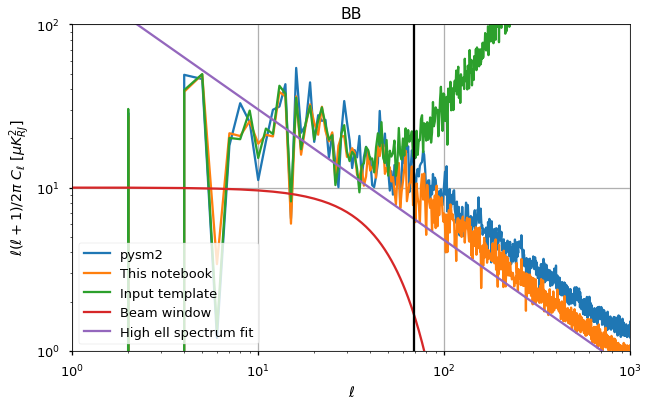
We can also compare with the synchrotron BB plot (Figure 7) from the PySM 2 paper below
[94]:
from IPython.display import Image
Image("BB_synch_PySM_2_paper.png")
[94]:
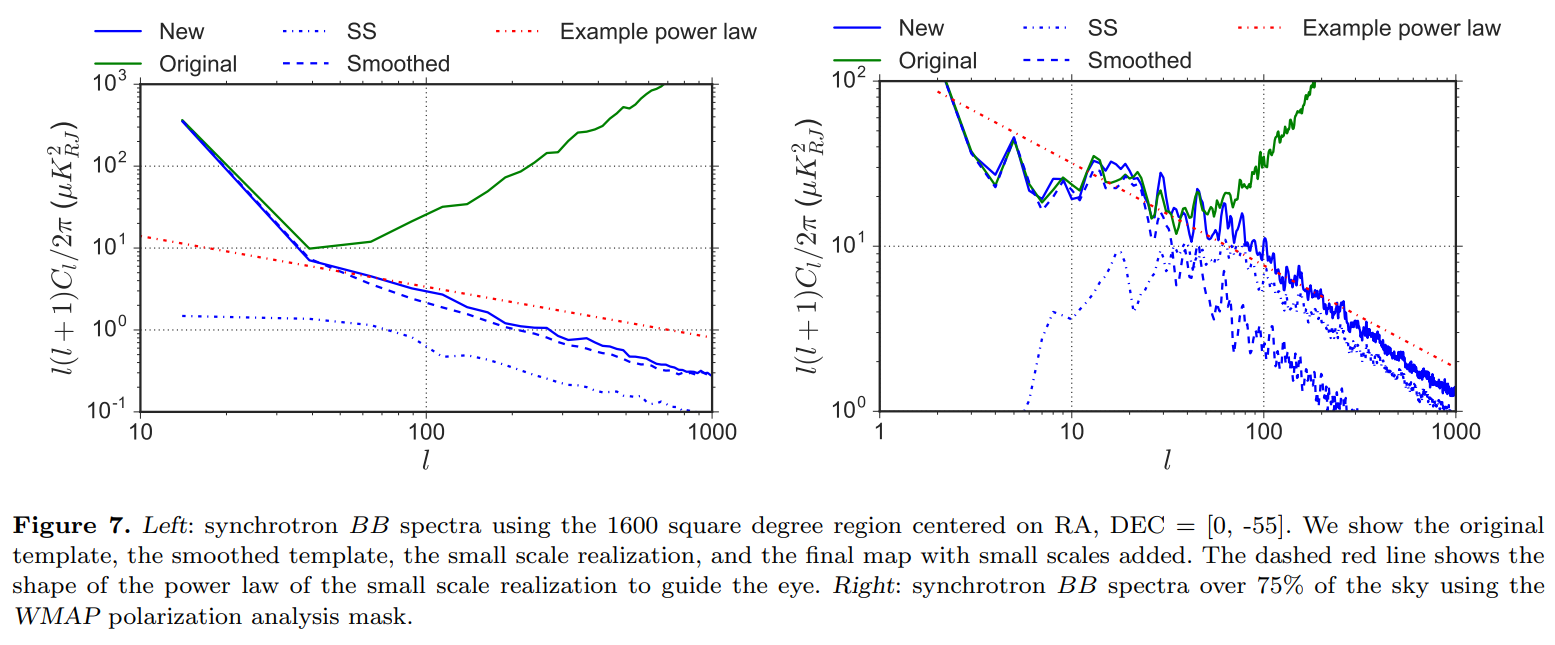
Conclusions¶
There are 2 issue with trying to reproduce the PySM 2 processing of the synchrotron templates for polarization:
the fit for the slope of the spectra at high \(\ell\) gives significantly steeper lines especially for BB, even denoising and considering cosmic variance error in the fit. It is possible that
namastergives a slightly different spectrum at low ell, it seems like the spice spectrum for BB has higher values at low \(\ell\) impacting the PySM 2 fitthe figure in cell 93, just above here, shows higher power in the \(\ell\) range 60-100 in EE, which should be over the beam cutoff so should just be dominated by the small scales realization
If anyone is interested in investigating this, the source notebook doesn’t require any external data and is available on Github, please open an issue to report your findings.